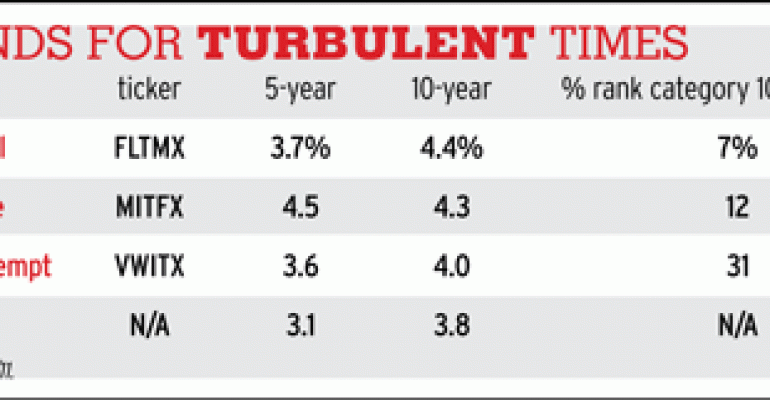Municipal bonds have sagged recently. During the three months ending Jan. 24, intermediate-term municipal funds dropped 4.6 percent, according to Morningstar. Analysts blame falling bond prices on a variety of causes, including rising interest rates and concerns about municipal defaults. Should you dump your bonds? No. The municipal default rate remains tiny, and yields on high-quality bonds are relatively rich.
While the dip in bond prices is probably temporary, the downturn has served to highlight the strengths of old-fashioned mutual funds. The best funds have come through the turmoil in relatively sound shape. Most investors who want to own municipals should buy a traditional fund instead of holding tax-free ETFs or individual bonds.
On the other hand, the downturn underlined the weaknesses of ETFs, which suffered particularly steep losses. In the past three months, SPDR Nuveen Barclays Capital Municipal Bond ETF (TFI) lost 7.3 percent, while iShares S&P National AMT-Free Muni Bond ETF (MUB) declined 6.6 percent. Part of the reason for the poor performance is connected to the structure of ETFs. Typical ETFs hold portfolios of securities and trade on exchanges like stocks. Most often, shares of ETFs sell for about the value of the assets in the portfolios. But during bear markets, the shares can sag and sell for discounts to the net asset values. That has happened lately.
In the last several months, the SPDR Nuveen fund has gone from trading at a small premium to a discount of about 1 percent. Because of the discount, investors who sell their ETF now will only receive 99 cents for each dollar of assets. Like ETFs, mutual funds hold portfolios of securities. But mutual funds always sell for their net asset values.

Despite their advantages, mutual funds are not the first choice for many advisors, who may prefer individual bonds. Investors who hold individual bonds to maturity can predict how much they will have at that time, advisors note. In contrast, the value of mutual fund shares changes every day. Advisors say that the variability of mutual funds unnerves clients.
Though it is true that mutual funds present some uncertainty, individual bonds have come to pose even greater problems in recent years. Before the financial crisis, the municipal market was relatively homogenous. Half of all municipals carried AAA ratings because they were insured. Investors in the insured bonds had little cause to worry about defaults, and prices of the insured bonds all tended to rise and fall in unison. Then insurers collapsed in 2008 because of losses they suffered in mortgage markets. Now only 7 percent of municipals are insured. Today’s uninsured bonds no longer move in lockstep as investors worry that weaker issues can be downgraded or default.
Trading individual issues has become more difficult as a result of the financial crisis. Bear Stearns and Lehman Brothers were major bond dealers before they went out of business. Surviving brokers now handle reduced trading volumes. That can make bonds more expensive to trade.
In the wake of the market meltdown, it can be harder than ever to assemble diversified portfolios of individual bonds. It costs at least $10,000 to buy most municipals. In the past, some advisors felt that each client needed to buy at least $500,000 worth of bonds to assemble a diversified portfolio. Now that the markets have become more erratic, it may require holding even bigger portfolios to achieve diversification. As a result, most clients can only afford to diversify properly by buying funds, which often hold hundreds of bonds.
For best results, buy conservative funds with sound track records. Top choices include Vanguard Intermediate-Term Tax-Exempt (VWITX) and Fidelity Intermediate Municipal Income (FLTMX). Both funds have outdone their categories by wide margins during the past 15 years, according to Morningstar. And because the funds have low expense ratios and consistent strategies, there is good reason to believe that the portfolio managers will continue outperforming.
Besides providing diversification, fund managers can reduce risk by steering away from shaky bonds. To appreciate the value of top managers, consider Marshall Intermediate Tax-Free (MITFX), which has returned 4.5 percent annually during the past five years, outdoing all its competitors. In the past, Marshall fund managers John Boritzke and Duane McAllister often emphasized general obligation (GO) bonds, which are backed by the full taxing power of municipalities. But these days, the fund has no local GOs and is underweight state GO bonds. At a time when some municipalities face possible rating downgrades, the GOs don’t offer rich enough yields to compensate for the risks, the managers figure. Instead, the fund has overweighted revenue bonds, which are backed by income from particular projects.
Favorite issuers include water and sewer systems. These collect consistent income from property owners who must pay bills on time in order to avoid having the water cut off. “Even in areas where housing values have fallen 40 percent, water revenue has been steady,” says Boritzke.
The Marshall fund keeps most of its assets in bonds rated AA and AAA. Those high-quality bonds should continue providing the reliable income that fund shareholders expect.






